- Home
- Basic embroidery stitches
- Cretan Stitch
My Secret to the Non-Wobbly Cretan Stitch
Oh, the Cretan stitch. For years, it was my stitching nemesis.
I’d see it in books and on beautiful crazy quilts, looking like a lovely, elegant little braid. But when I tried it? I got a wobbly, uneven zig-zag that looked like it had had one too many coffees. It was maddening!
If you’ve ever felt that frustration, please know: you’re not the only one, and it’s not your fault!
The secret to taming this stitch is wonderfully simple: guide lines.
Creating a path for your stitches removes all the guesswork and lets you focus on the relaxing rhythm of stitching, which is what this is all about!
We are going to draw three parallel lines. For a delicate decorative stitch, aim for a total width of about a quarter-inch (around 6mm) from the top line to the bottom line. Of course you can make this wider if you are planning to use a chunky thread.
The top and bottom lines will be the edges of your stitch, and that middle line will be your trusty anchor point.
Let’s Stitch! Your Step-by-Step Guide to a Flawless Cretan Stitch
Grab your supplies, and let’s do this together. It’ll be fun, I promise! For our method, we are going to draw all three guide lines to ensure you get a beautifully neat result right from the start.
You’ll need:
- A small piece of fabric (Calico is great for practice!)
- Some embroidery floss (I’m using 2 strands of DMC Coloris, shade 4504)
- An embroidery needle
- A pencil or fabric marker (optional, but so helpful for those guide lines!)
A quick, friendly note on fabric markers: There are two common types, and choosing the right one can save you a headache later!
- Air-Erasable Pens (often purple or pink): These are brilliant if you plan to finish your stitching in one or two sessions, as the ink magically fades on its own within a day or so.
- Water-Erasable Pens (often blue): If you're a stitcher who likes to take your time or might set the project aside for a few days, this is your best friend. The lines will stay put until you're all finished and decide to remove them with a quick dab of water.
Now that you've got the perfect pen for your pace, let's get those lines drawn and start stitching!
Step 1: The First Stitch and The "Blanket Stitch" Connection
With your three guide lines carefully drawn, you're ready to make your first cretan stitch!
Start by bringing your needle up from the back of the fabric, popping up right on the middle line.
Next, guide your needle down into the fabric on the very top line, just a tiny bit to the right. Now, bring the needle's tip back up in the empty space, aiming halfway between the top and middle lines.
Now for the magic loop! Before you pull the needle all the way through, make sure your working thread (that's the length of floss coming from the fabric) is tucked underneath the tip of the needle.
Pull the thread gently until the loop lies flat. Great work! That's the first half of your very first stitch complete.
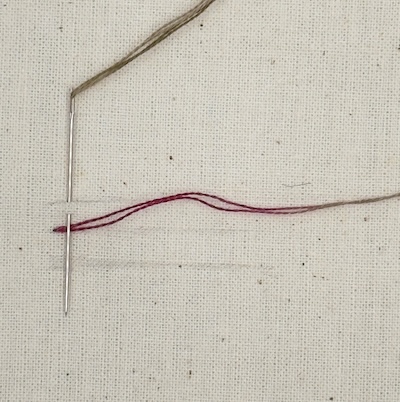
Step 2: The Little Flip
Time to complete that first beautiful stitch!
Turn your needle so it’s pointing up, and guide it into the fabric on the bottom line. Now, bring the needle's tip back up in the empty space, aiming halfway between the bottom and middle lines.
Just like you did before, make sure the working thread is tucked underneath the needle's tip before you pull it through.
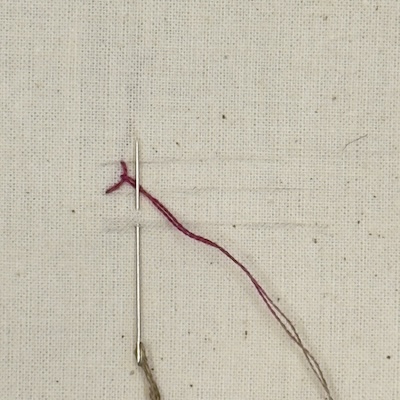
Pull it through gently, and look at that! You’ve made your first complete Cretan stitch. We’re on a roll! This is a fantastic "immediate win" and should give you a big boost of confidence.
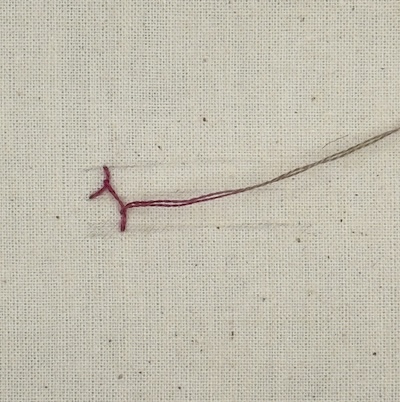
Step 3: Finding Your Rhythm
Now we just repeat that lovely little dance.
Turn your needle so it’s pointing down again. Guide it into the fabric on the top line and bring the needle's tip back up halfway between the top and middle lines.
Just as before, tuck the working thread under the needle before pulling it through.
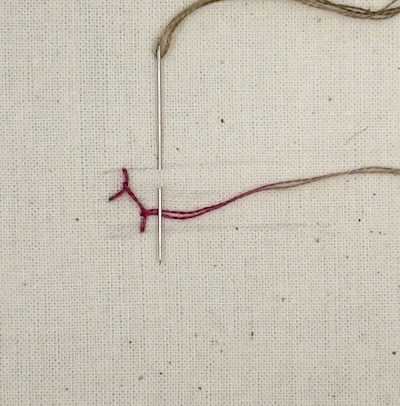
A friendly tip for smooth stitches: My first attempts at this stitch always ended up in a puckered, wrinkly mess because I pulled the thread way too tight.
The trick is to be gentle! You’re just guiding the thread into place, not wrestling it.
A soft tug is all it needs to lie flat. This keeps your fabric smooth and makes the whole process feel so much more relaxing.
Step 4: Keep on Groovin'
You've totally got the rhythm now! This is the fun part where you see that beautiful, textured braid start to form.
Just continue that gentle, alternating dance down the line, making a stitch on the top, then a stitch on the bottom, and so on.
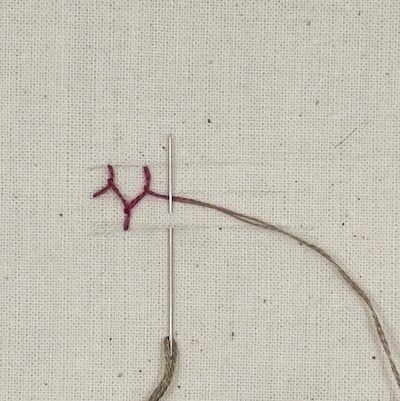
You'll quickly see how your three guide lines are doing all the hard work for you. They make it easy to keep your stitches even and consistent, which is the whole secret to that smooth, flowing effect you're after. No more guesswork!
Step 5: The Tidy Finish (and a Peek at the Back!)
You've made it to the end of the row? Fantastic work!
Now, let's secure that thread so your beautiful stitching never comes undone. This also happens to be one of my favourite parts: the moment we get to flip the hoop over and admire our handiwork.
Go on, take a peek at the back. You should see a wonderfully tidy pattern of neat, vertical stitches. No messy knots or tangled threads here! That clean finish is the lovely bonus you get from using guide lines to control your stitches.
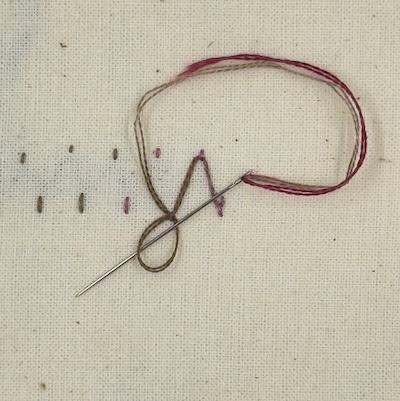 Fastening off
Fastening offHere’s my simple, three-step way to fasten off securely on the back:
- First, gently slide your needle under the last stitch you made.
- For good measure, slide it under the stitch right before that one, too.
- Now, on that second stitch, before you pull the needle all the way through, loop your thread around the tip of the needle to form a tiny, secure knot.
Snip your thread close to the knot, and that's it! A beautiful front and a tidy back. That's a huge stitching win you can be incredibly proud of.
A Little "Oops" and a Big Lesson: What My Stitches Taught Me
Alright, you now know the fundamental rhythm of the Cretan stitch. But I want to show you something that happened as I was stitching the very sample in these photos, and it’s the best lesson I can give you.
Take a look at my row of stitches.
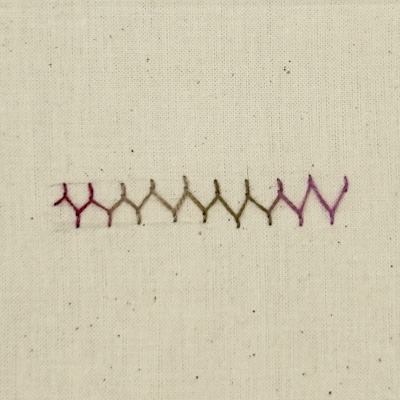 Completed row of cretan stitch
Completed row of cretan stitchFor the first few repeats, I was carefully hitting my top, middle, and bottom guide lines, and the braid is nice and even.
But then... I got a little complacent. You’ll see the row suddenly widens. That's where I missed hitting the bottom line, making the stitch longer. A few stitches later, it widens again! That’s where I missed the top line, too.
Instead of unpicking it, I left it in as a reminder.
This little "oops" is the perfect visual for why sticking to those guide lines is so useful.
They are your ticket to a neat, even braid, while veering off-course gives you a more organic, freeform look. There are no mistakes in embroidery, only creative choices!
Help! Why Does My Stitch Look Like Barbed Wire?
Are you following the guide lines, but your stitch is coming out flat, with sharp little spikes coming off a central line? Does it look less like a delicate, interwoven braid and more like... well, a tiny, embroidered strand of barbed wire?
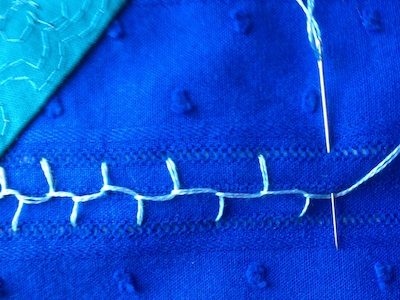
If this sounds familiar, don't worry! This happens for one very simple reason.
The Cause: This "barbed wire" effect is the result of bringing your needle up on the center guide line every single time, instead of in the space between the lines.
The Simple Fix: Remember the rhythm we practiced in the tutorial?
The center line is your starting point, but after that, your needle should always come up in the empty space—halfway between the top and middle lines, or halfway between the bottom and middle lines.
This is what allows the stitches to overlap and weave together in the middle, creating that beautiful, textured braid instead of flat barbs. It's a small change in placement that makes all the difference in the world!
Your Cretan Stitch Adventure Begins!
You've done it! You've learned the rhythm, sidestepped the "barbed wire" pitfall, and mastered a beautiful new stitch. A huge congratulations!
But this is just the beginning. The best part about learning a new stitch is figuring out all the fun ways you can use it. The Cretan stitch is a superstar in crazy quilting and for adding unique textures to any project.
Here are a few ideas to get your own creativity flowing:
1. Simple & Elegant Seams
As you can see in the top row of my first photo below, just a single row of Cretan stitch along a seam is beautifully effective. It creates a clean, textured braid that adds a touch of handmade elegance all on its own.
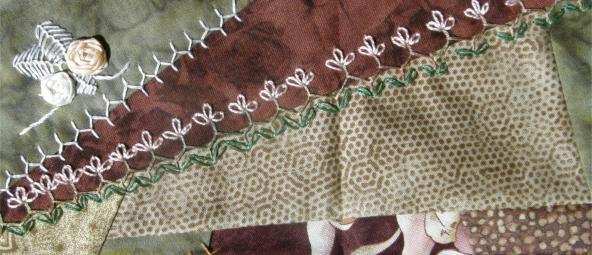
2. A Touch of Sparkle
Ready for a little sparkle? Try adding a tiny seed bead to the tip of each "arm" of the stitch. You can even stitch two overlapping rows and add beads, as I did in the next photo. It's such a simple touch, but it looks so delicate and catches the light beautifully.
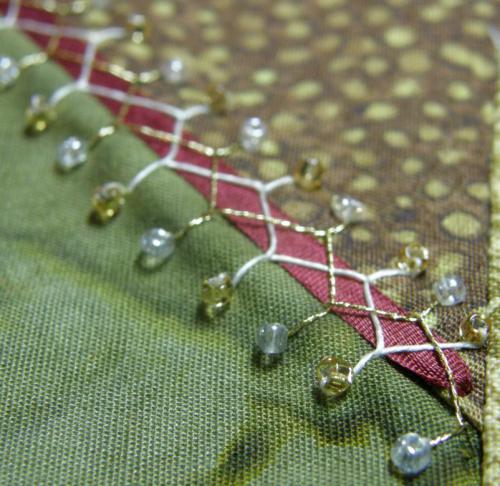
3. Stitch a Whimsical Garden
This is where you can really start to play.
As shown in the photos below, you can use your Cretan stitch as a vine and add other stitches to create flowers and leaves. I added three simple straight stitches in green, then topped them with a dark pink lazy daisy stitch. A few French knot buds on the shorter stems finish the look. Why not try different combinations to grow your own unique garden?
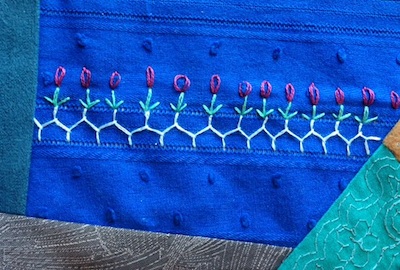
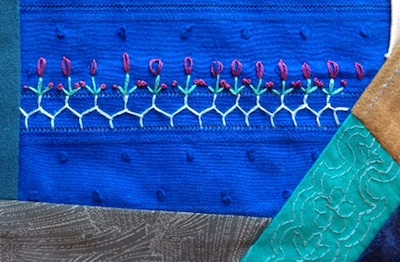
4. Create Leaves with a Raised Vein
The Cretan stitch is absolutely perfect for filling in shapes, especially leaves.
Just draw a simple leaf shape and then fill it with tightly packed Cretan stitches. The central braid creates a perfect "vein" for the leaf, giving it a wonderfully natural texture.
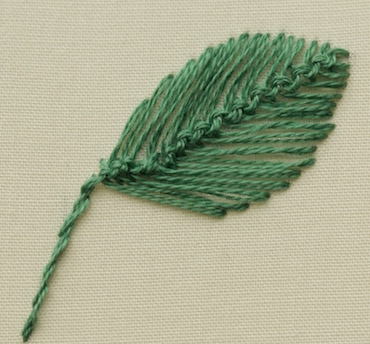
This new stitch is now part of your creative toolbox. I hope this guide has helped turn it from a tricky technique into a trusted friend.
Have fun playing with it, and I'd love to see what you make!
Been There, Stitched That? Share Your Work!
Now it's your turn! Did you give the stitch a go? Did you discover a brilliant colour combination or have a little "aha!" moment of your own?
I would be so thrilled to see your creations and maybe even feature them here to inspire other stitchers. Seeing your work is the best part of my day!
Drop a photo and your story in the form below. Your experiments and questions are what make this little corner of the internet so special.
Stay connected between projects
If you’d like occasional updates from my embroidery room, including new patterns, gentle tips, and little things I think you might enjoy, you’re warmly invited to join the Stitchin’ Times newsletter.
No pressure. Just a friendly note now and then to keep you inspired.


